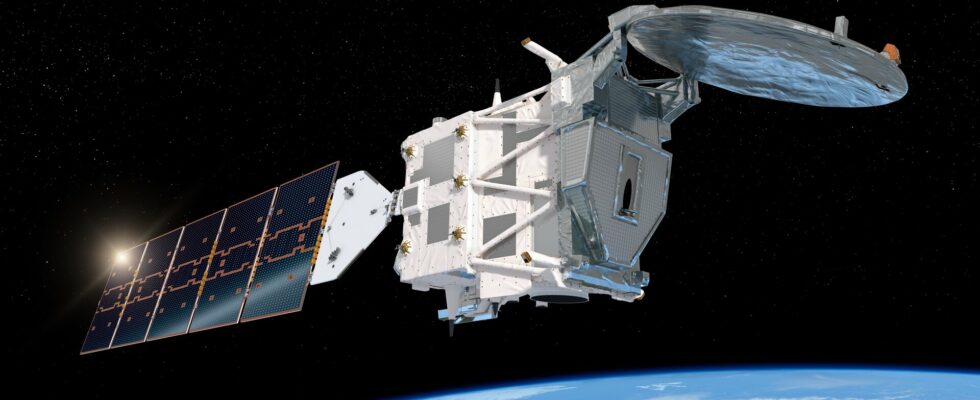- A quest more complicated than expected
- A unique scientific contribution
- After hesitation, time for action
This Wednesday, May 29, this new satellite from the European Space Agency and Japan will take off to study clouds, aerosols and the terrestrial radiative environment. This cutting-edge scientific mission should refine climate models and the understanding of complex mechanisms in the atmosphere.
Among the Earth observation satellites deployed by major agencies, only a small fringe is devoted to understanding phenomena that are still (relatively) poorly documented. The role of clouds as well as their interaction with aerosols and the terrestrial and spatial radiative environment are a key to better studying the climate as a whole and refining terrestrial models, in particular the projections.
ESA, the European Space Agency, started the EarthCARE project in the early 2000s, then supported by the Japanese agency, JAXA. But this major mission did not go smoothly. Among the four complementary instruments it carries, one of them was practically invented for the occasion.
A quest more complicated than expected
When it signed the development contract for the satellite in 2008, with a budget of 263 million euros, the European agency had not yet taken stock of what would be asked of the research and development laboratories. The objective of EarthCARE, for its part, is clear: to precisely identify the role of clouds and aerosols on the climate with their participation in the greenhouse effect. In particular, EarthCARE will be equipped to understand and document the interaction of clouds and aerosols with solar and terrestrial thermal radiation.
This requires instruments capable of precisely measuring clouds, which is particularly complex. Images, even multispectral ones, can only identify part of their overall shape. So, in addition to an optical sensor (called MSI), EarthCARE embeds a particular radar which will be capable of establishing the precise internal structure of the clouds: the Japanese CPR (Cloud Profiling Radar) instrument.
The CPR will work with a third instrument, an ultraviolet LiDAR called ATLID which, thanks to laser emissions, can reconstruct the 3D shape of a cloud. It is this sensor which was incredibly complex to create, but also to test. And it’s French! A LiDAR of the same type (but with different characteristics) was carried by the ESA Aeolus mission, which measured wind profiles across the entire atmosphere. This applied research work and industrial realization lasted almost a decade and pushed back the schedule of the entire mission, doubling the final costs. The satellite was initially supposed to be delivered in 2018, then 2020!

A unique scientific contribution
EarthCARE has a fourth sensor reserved for radiative measurements, which will be able to differentiate between the thermal radiative budget from the Sun and that from the Earth. Our planet emits heat thanks to its heart, but also thanks to the reflection of the Sun’s rays on its surface and that of the clouds, as well as thanks to dust suspended in the atmosphere. These last two points are of particular interest to scientists on this mission. The satellite will fly in a low polar orbit and will be able to carry out its measurements over the entire globe, with a period of 25 days between two passes over exactly the same point. In addition to its instruments, the mission benefited from the contribution of 75 companies, mainly located in the Netherlands, Germany, Italy and Japan.
EarthCARE is not a very large satellite, although it is the most complex of ESA’s Earth Explorers projects. It measures approximately 3 x 2.5 x 2 meters when folded, but it still weighs a whopping 2.2 tonnes on the scale. Built by Airbus Defense & Space, it is equipped at the front with the large reflector dedicated to the CPR radar, and at the rear with a single wing including 5 solar panels 14.5 meters long.
The orbit of this chemically powered satellite, which will have to operate for a mission of at least 3 years (and more likely 5), is to operate at a relatively low altitude of 390 kilometers. To avoid having to raise its orbit too often, it is therefore “profiled” to have the smallest possible surface area and avoid as much atmospheric friction as possible. The coating of its walls (the famous MLI, for Multi-layer Insulation) is also special, because the classic outer layers gilded with gold do not resist the friction of oxygen molecules well.


EarthCARE has been the subject of more ground tests than the majority of scientific satellites, because of its instruments, and especially its precious and unique LiDAR, which carries numerous optical components. Indeed, during takeoff, the optical bench will vibrate, and as with the largest telescopes, it will be necessary to be able to adjust all the elements with unprecedented precision for optimal performance.
After hesitation, time for action
EarthCARE’s takeoff itself is an adventure in its own right. During its development, it was planned to send the satellite into orbit under the fairing of a Soyuz rocket. However, in 2022, Russia’s invasion of Ukraine sends cooperation with the Russians to the ground, and no Soyuz rocket takes off from Guyana anymore. It is then a question of sending EarthCARE with a Vega C rocket. But this has also been banned from flight since December 2022 and its scathing failure with two Airbus Earth observation satellites.
The time to return to flights or to choose Ariane 6, and the most precise scientific mission on clouds and aerosols was likely to spend 2024 and 2025 in a container. Once again, Europe has called on the inconvenient American partner (SpaceX). The latter, who is no longer in his trial run, has managed to spare a place in his manifesto for what will be, unless I am mistaken, their 55e Falcon 9 flight this year.


After its launch, scheduled for 12:20 a.m. on May 29 (Paris time) in fog (traditional and probable) from the Californian site of Vandenberg, EarthCARE will quickly contact the stations of Kiruna (Sweden) and Induvik (Canada) to reach its final position and start its tests in orbit. These will probably last several months before the start of the scientific campaign, the results of which will be shared between Europe and Japan.
Source : Airbus


0